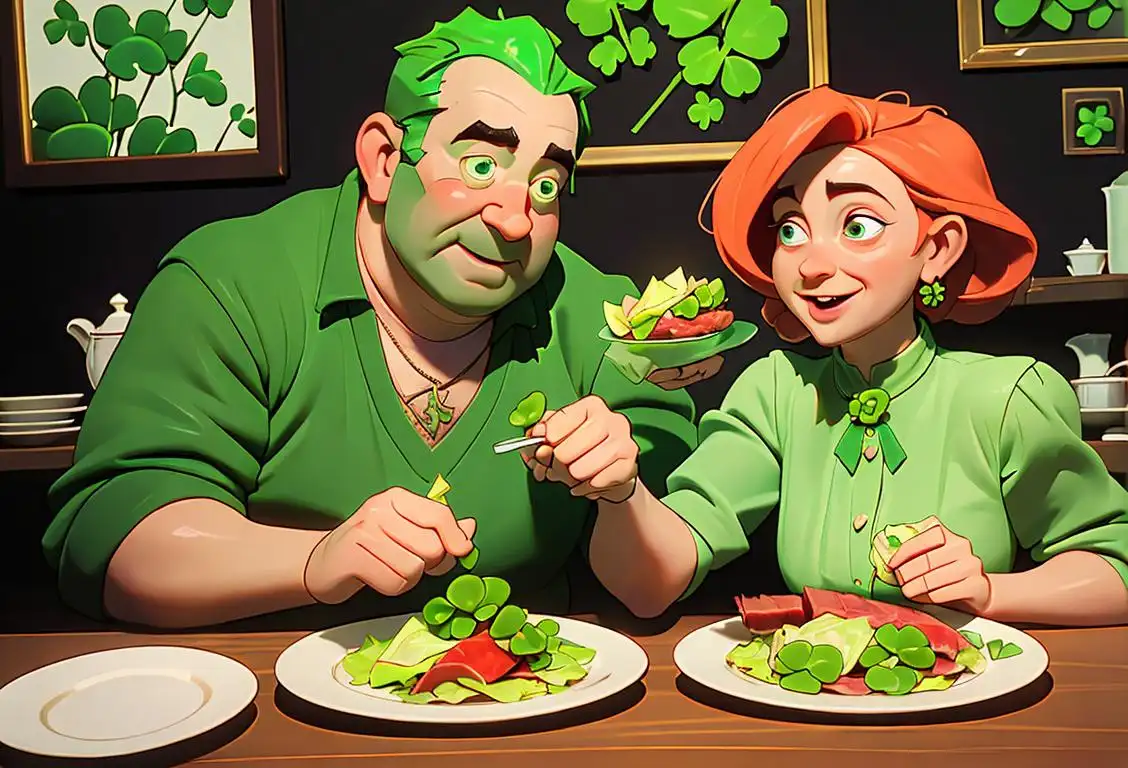National Corned Beef And Cabbage Day

Welcome to National Corned Beef and Cabbage Day! Get ready for a tantalizing journey into the world of this traditional Irish dish. Whether you say it's 'corned beef' or 'corned beef and cabbage,' one thing's for sure: it's a mouthwatering combination that'll have you feeling lucky and hungry all at once.
When is Corned Beef And Cabbage Day?
It's national corned beef and cabbage day on the 17th March.
The Origins of National Corned Beef and Cabbage Day
Did you know that corned beef and cabbage wasn't really an Irish tradition until Irish immigrants brought it to America? That's right! While many Americans associate this tasty combo with St. Patrick's Day, it actually originated in the United States as a way for Irish immigrants to celebrate their heritage.
The tradition of serving corned beef and cabbage on St. Patrick's Day started in the late 19th century when Irish immigrants in America substituted corned beef for traditional Irish bacon, which was more expensive and harder to find.
Soon, this delightful dish became a staple on St. Patrick's Day menus across the United States, and its popularity grew. Over time, corned beef and cabbage became synonymous with Irish-American cuisine, and now it gets a whole day of celebration dedicated to it!
How to Celebrate National Corned Beef and Cabbage Day
Celebrating National Corned Beef and Cabbage Day is as easy as pie—well, corned beef and cabbage pie, that is! Here are a few ways you can revel in the deliciousness:
- Host a traditional Irish feast: Invite your loved ones over for a scrumptious meal of corned beef and cabbage, served with some buttery potatoes, of course. Don't forget to wear green!
- Get creative in the kitchen: If you're feeling adventurous, try incorporating corned beef and cabbage into other dishes. Corned beef hash and cabbage rolls are just a couple of examples.
- Support your local Irish pub: If cooking isn't your forte, head out to a nearby Irish pub and indulge in their special St. Patrick's Day menu. You'll get all the flavor without any of the cleanup!
Did You Know?
Did you know that the largest St. Patrick's Day parade in the world takes place in New York City? With over two million spectators annually, this iconic event is a must-see for any St. Patrick's Day enthusiast. So, whether you're Irish or just Irish at heart, make sure to add the New York City St. Patrick's Day Parade to your bucket list!
History behind the term 'Corned Beef And Cabbage'
1668
The Origins of Corned Beef
The term 'corned beef' originated in 17th century England, specifically around the year 1668. 'Corned' refers to the large grains of salt used to preserve the beef, which were called corns. The salt was rubbed into the beef to cure it, preserving it for longer periods of time. This method of preservation helped ensure that the beef would remain edible during long voyages at sea.
1668
Preservation Techniques
In the year 1668, the term 'corned beef' originated as a method of preserving meat by using coarse grains of salt, also known as 'corns,' to cure the beef. This process involved rubbing the beef with the salt to draw out moisture, preserving it for extended periods. The term 'corned' refers to the salt grains used to cure the beef, rather than any relation to corn.
1622
The Arrival of Corned Beef in North America
In 1622, the term 'corned beef' made its way to North America through Irish immigrants who brought the tradition of salt-cured beef with them. 'Corned' refers to the large grains or 'corns' of salt used to preserve the meat. Corned beef quickly became a staple in Irish-American cuisine.
1850
Irish Immigrants Bring Corned Beef to America
In the mid-19th century, a large wave of Irish immigrants arrived in America, fleeing from the Great Irish Famine. These immigrants settled in cities like New York and Boston, where they sought to recreate the tastes of their homeland. One of the traditional Irish dishes they brought with them was corned beef. In Ireland, however, corned beef was usually considered a luxury and was not commonly consumed by the majority of the population.
1845
The Great Potato Famine
During the mid-19th century, Ireland faced one of its most devastating periods known as the Great Potato Famine. This catastrophe led to a mass migration of Irish people to the United States. As Irish immigrants settled in America, they continued their culinary traditions, including the consumption of corned beef and cabbage.
1845
Irish Immigration to America
In 1845, during the time of the Irish Potato Famine, a significant wave of Irish immigration to the United States began. Many Irish immigrants settled in large cities like New York and Boston, where they brought their culinary traditions with them. Corned beef was already a popular meat in the United States, so Irish immigrants started incorporating it into their cooking, adapting it to their own tastes and preferences.
Late 1800s
New York City's Delis Popularize Corned Beef Sandwiches
As the Irish immigrants settled in urban areas, particularly in New York City, they encountered Jewish delis which had started to serve corned beef as a staple in their menus. These delis were quite popular and introduced corned beef as an affordable and easily accessible meat option to the Irish community. Corned beef began to gain popularity and became synonymous with Jewish delicatessens.
1845
Irish Immigration
During the mid-19th century, a significant wave of Irish immigrants arrived in the United States, particularly in cities like New York and Boston. As they settled in their new homes, they brought along their culinary traditions, including the preference for hearty and affordable meals. This mass migration played a vital role in popularizing the term 'corned beef and cabbage' in the United States.
Late 19th Century
Corned Beef and Cabbage in Irish-American Cuisine
During the late 19th century, corned beef and cabbage became a staple dish in Irish-American cuisine. While corned beef was not commonly eaten in Ireland itself, it became closely associated with Irish-American culture and is often associated with traditional Irish meals and celebrations, particularly St. Patrick's Day. As Irish immigrants assimilated into American society, they adapted their culinary traditions to available ingredients, and corned beef and cabbage became a beloved and iconic dish.
Mid-20th century
St. Patrick's Day Tradition Emerges
Over time, the association between corned beef and the Irish community grew stronger, and it became a traditional dish served on St. Patrick's Day. This cultural shift was influenced by several factors, including the affordability and availability of corned beef, as well as the social interactions between Irish and Jewish communities. As St. Patrick's Day parades and celebrations became more prominent in cities like New York, corned beef became a popular food choice to commemorate the festivities.
1871
Corned Beef and Cabbage Becomes a St. Patrick's Day Dish
By the late 19th century, corned beef and cabbage had become a popular dish among Irish-American communities, particularly in cities like New York and Boston. It was an affordable and readily available meal for immigrants, making it a comforting reminder of their homeland. The association between corned beef and cabbage and St. Patrick's Day began during this time, although it was primarily an American tradition.
Early 20th Century
St. Patrick's Day Feast
As the Irish population grew in the United States and St. Patrick's Day celebrations became more widespread, 'corned beef and cabbage' became closely associated with the holiday. While the dish did not have a strong affiliation with Irish cuisine, it became a staple of the festive meal due to its affordability and availability in Irish-American communities.
1925
Corned Beef's Rise to Popularity
In the early 20th century, corned beef and cabbage gained widespread popularity beyond Irish-American communities. It became a symbol of St. Patrick's Day across the United States. The dish's association with Irish-American heritage contributed to its cultural significance. Restaurants and pubs started serving corned beef and cabbage as a featured menu item during the holiday, solidifying it as a traditional Irish-American dish.
Marketing Influence
Prominent Delis
In the early 20th century, New York City's Jewish delis played a significant role in solidifying the popularity of 'corned beef and cabbage.' These delis, known for their corned beef sandwiches, skillfully marketed the dish as a traditional Irish meal, further entrenching its association with St. Patrick's Day. The marketing efforts successfully influenced public perception and made 'corned beef and cabbage' a celebrated dish during the holiday.
Modern Day
Corned Beef and Cabbage as an Irish-American Dish
Today, corned beef and cabbage is widely considered a traditional Irish-American dish, particularly associated with St. Patrick's Day. Interestingly, while it is now seen as an essential part of Irish cuisine, it is not as commonly consumed in Ireland compared to the United States. This cultural evolution showcases how food traditions can evolve and adapt within different contexts and communities, creating new culinary identities.
Modern Era
Symbol of Irish-American Heritage
Today, 'corned beef and cabbage' holds a prominent place as a symbol of Irish-American heritage and cultural identity. Although it may not be the typical dish consumed in Ireland for St. Patrick's Day, it has become deeply ingrained in the traditions of Irish-Americans across the United States. The flavorful corned beef paired with tender cabbage continues to be enjoyed as a delicious reminder of the immigrants' blending of culinary influences and the unity of diverse cultures.
1962
Presidential Reception of Corned Beef and Cabbage
In 1962, President John F. Kennedy hosted an official St. Patrick's Day reception at the White House. As an Irish-American, he wanted to celebrate his heritage and showcase traditional Irish-American cuisine. Corned beef and cabbage prominently featured on the menu, cementing its status as a beloved dish associated with St. Patrick's Day in the United States.
Did you know?
Did you know that the largest St. Patrick's Day parade in the world takes place in New York City?Tagged
food fun loved onesFirst identified
17th March 2016Most mentioned on
17th March 2016Total mentions
213Other days
Biscuit Day
Cheese Lovers Day
Cheese Pizza Day
Agriculture Day
Bacon Day
Medal Of Honor Day
Pumpkin Day
Foundation Day
Guac Day
Drink A Beer Day









